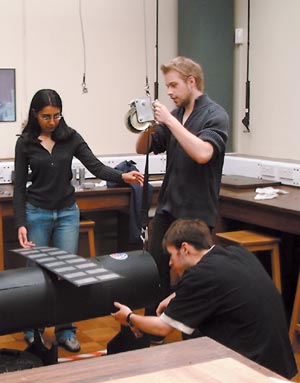Derek Raine explains why academic physicists must reconsider their approach to teaching
Let’s try a test. If I were to tell you that this article is about academic-staff development, would you: (a) laugh and move on; (b) initiate a group discussion on the decline of physics; (c) read on, but only after checking that no-one is watching; or (d) look forward to an opportunity to talk about how to reform teaching? I suspect that few academic physicists would answer (d). Why the negativity? Is it because we think of staff development as something that is done to us (usually at great length) rather than something we do for ourselves?
Let me put it differently: this article is about developing the teaching of physics and about how we can communicate the “tingle factor” of physics to a larger number of potential students. That ought to be important to us. But the impression I get is that teaching is often considered to be easy, even though much of it proves to be ineffective. If we continue to believe that poor learning is all the fault of the students, then we do ourselves – and physics – no favours.
Developing new approaches
Of course, teaching is fairly easy if one has like-minded students. Academics are physicists in the same way that musicians are musicians; for those students who are like our former selves there is very little teaching to be done. But about half of all physics graduates are not going to become professional physicists. We need them not just for the money that their tuition fees contribute to departmental budgets, but also for the skills they will bring to industry, commerce and perhaps even school teaching. Our students therefore need to graduate with something more than an in-depth understanding of why physics was not for them.
We face two enormous problems. First, the cohort of school-leavers going into university physics is constantly changing as a result of the increasing diversity of higher education. And second, the knowledge and ability of those who do come into physics is more variable than in the past. Physics is no longer the main attraction for mathematically talented students, who now often go into economics or computer science. Moreover, the physics that they experience at school bears little relation to the subject that their university teachers studied.
Does this matter? The honest answer is that no-one knows. Intuitively, mastering physics is like acquiring a language, which becomes increasingly difficult the longer it is delayed. However, we do not actually know how students acquire a physical picture of the world in which, for example, Newtonian mechanics becomes the first natural language and the naive Aristotelian view – that a force is required to maintain velocity – fades to a distant memory.
Some education researchers, notably in the US, have devised ways of splitting physics into logical morsels that can be parcelled out in the correct order to students. Like putting atoms together, a meaningful structure somehow emerges at a higher level. This could well be the way (or at least one way) to acquire a proper world-view, and it may be that recent changes to UK A-level physics syllabuses – which emphasize concepts and applications – is a similar step in the right direction (“Back to the future”).
The only thing that is certain is that we are faced with a very different challenge today to ensure that we have enough physics graduates in the future. I do not want to exaggerate here, but I would point out that, although fortunately no physicists were implicated, the decline of Roman civilization began with its failure to educate its citizens to the professional classes.
Changing courses
Despite the infuriating belief in some circles that physics at universities is immune from developments in teaching and learning, physics departments have, in fact, been among the leaders of change in many institutions. There are two strands to this reform, which one might label as “developments within physics” and “developments of physics”.
To give some examples from within physics, all undergraduate physics programmes that I know of at UK universities now include some group work as a way of developing presentation and communication skills as well as team problem solving. There is a growing use of project work to encourage independent learning and make students more employable. There have also been big efforts in computer-assisted learning and in the use of simulations to generate understanding where pure mathematics might too often fail. Moreover, heroic efforts have been made to improve students’ mathematical skills – including extensive tests, software and remedial classes – rather than to “dumb down” the content of such courses. Staff are also beginning to develop so-called virtual learning environments as something more than a repository for lecture notes. Other novelties include the use of drama and asking students to lecture on a particular topic for no longer than a minute.
These, however, are mainly insertions into the traditional lecture programme. A more systematic way of making physics interesting – and at the same time improving students’ employability – is problem-based learning (PBL). Having been used for almost 40 years in undergraduate medicine in North America, Australia and more recently in Europe, it is now seen as a trendy, but potentially useful, approach in other disciplines, particularly in engineering. PBL has so far not been used extensively in university physics courses, with the exception of the University of Delaware in the US, where it has been adopted across the institution. The Dublin Institute of Technology in Ireland is another notable exception; here the PBL approach to physics has been extended to the whole curriculum up to second-level courses (first-year undergraduate level in Britain). Meanwhile, physics departments that are members of the Problem-Based Learning in Astronomy and Physics project – led by the University of Leicester – are fostering PBL with support from the Higher Education Funding Council for England.
As for reforms that come under the banner “developments of physics”, I am thinking primarily of the Institute of Physics’ inquiry into university physics, chaired by Sir Peter Williams (Physics World October 2001 p5). It suggested a role for a more interdisciplinary degree that would, at least in the initial years, be less dependent on mathematical skills. Certainly, giving students three years to master the necessary mathematical skills – rather than convincing them in the first term that they are not able to do so – might be a good thing for both students and staff. But the important point about interdisciplinarity is that, for the students who are not going to be theoretical particle physicists or the like, interdisciplinary research is where most of today’s interesting physics lies. By embedding physics in an interdisciplinary mantle, we do not just tell students that physics is important, we show them.
The i-Science Centre at Leicester (where the “i” stands for interdisciplinary or integrated) will be one of the first to mount such a degree programme and will endeavour to foster the development of i-science elsewhere. A related, context-based approach to physics, in which the emphasis is on themes such as “energy” and “the environment”, has been proposed by the Department for Educational Studies at the University of York. Such work is a natural development of other integrated approaches to science teaching in schools and will, in the longer term, be a natural route through science education for an increasing number of students. It represents an alternative and possibly more fruitful approach to the increasing lack of relevant mathematical preparedness of new physics students.
Of course, no institution is going to take materials from a rival programme – however good – and simply duplicate them. If academic staff are to be committed to – and enthusiastic about – new forms of teaching, they need to have prepared and devised
the relevant teaching materials themselves. “Ownership” is all important. Nevertheless, exchanging information about teaching developments is still vital to prevent others from reinventing the wheel. If teaching is to develop through new approaches to physics – rather than through simple revisions to existing programmes – then academic staff need to become actively involved in the process.
Broadening the appeal
So how can further improvement be fostered within the wider community? Unfortunately, teaching development carries a low esteem relative to “real” research, even though enabling the next generation of students to fulfil their full potential is so important. One reason is structural. Teaching developments are often ghettoized and die when the person who champions them retires. As one astronomer royal once put it to me, research is an indelible contribution to the development of science even when it turns out to be completely wrong, whereas teaching is ephemeral if it is not embedded beyond the grave (or, happily in most cases, beyond early retirement).
But there is another simple reason for the low esteem of teaching: high-status activities are generally regarded as those that bring in “overheads” to a university department, whereas teaching development costs money and leaves staff with less time for research. Various attempts to address this problem through prizes and development grants do not address directly the comparability with research. One simple solution could be to provide individual academic staff (and teams of staff) with grants to develop teaching, perhaps based on applied research into higher education. Such grants should, ideally, contribute an overhead to the university. They should also have the same status as research grants, particularly as far as the UK’s Research Assessment Exercise is concerned.
From later this year the new Higher Education Academy will integrate the roles of the Learning and Teaching Support Networks and the Higher Education Institute for Learning and Teaching in the UK. These have played a modest role in providing funding for teaching. Perhaps the academy can expand this provision but on a much larger scale, and perhaps then you would read an article on teaching development – in the hope of seeking major funding opportunities to do such work for yourself.




